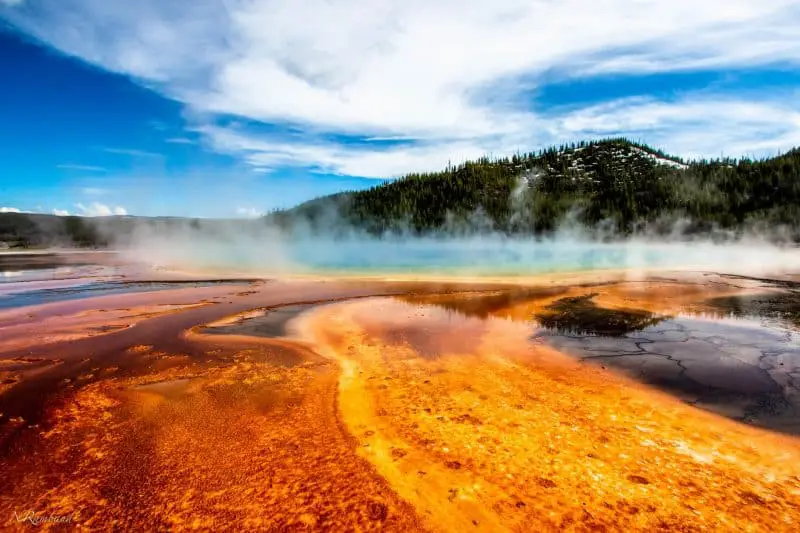Welcome to the untamed world of Wyoming’s animals and wildlife, where the rugged landscapes and sparse human population create a haven for a diverse array of untamed creatures. With over 100 mammal species and 400 species of birds, Wyoming’s wilderness is a thriving habitat for iconic residents such as bison, mountain lions, wolverines, bobcats, grizzly bears, black bears, elk, moose, deer, pronghorn antelope, and even the majestic wild horses. Join us on an exploration of the natural wonders that call Wyoming home, where every corner reveals a new chapter in the captivating story of the state’s vibrant wildlife.
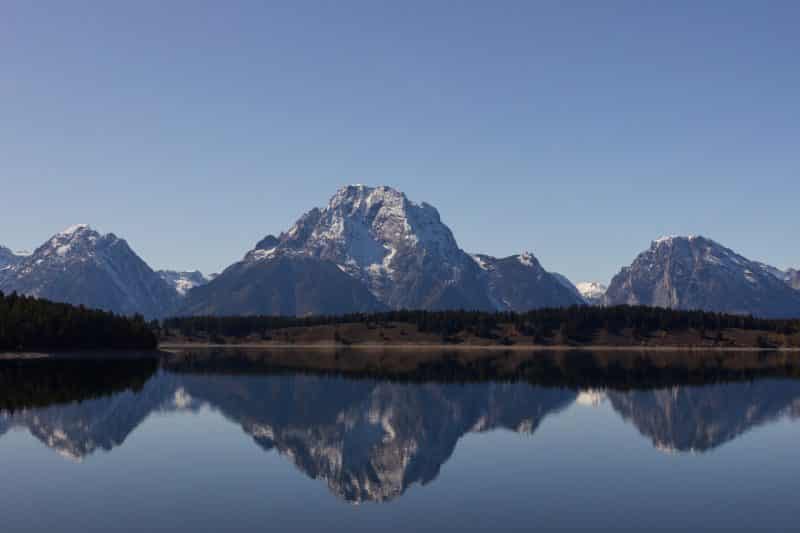
This blog will pinpoint a few wildlife species in Wyoming, as there are two National Parks in the state of Wyoming: Grand Teton National Park and Yellowstone National Park.
Please use the headings below or enjoy the whole blog in its entirety. Don’t forget to leave a comment sharing your experience of wildlife in Wyoming or your plans to go there one day!
Key Points
| Aspect | Information |
|---|---|
| Bison | – Wyoming’s state mammal since 1985. |
| – Yellowstone habitat since prehistoric times. | |
| – Largest bison population in US, roam freely in Yellowstone. | |
| – Display wild behaviors, congregating, migration, exploration. | |
| Physical Characteristics | – Largest land mammal in North America. |
| – Males 2,000 lbs (900 kg), females 1,100 lbs (500 kg), dark brown with hair variations. | |
| – Calves born reddish-tan, turn brown. | |
| Behavior | – Agile, strong swimmers, run 35 mph, jump 5 feet, keen senses. |
| – Diet: grasses, sedges (90%), ruminants with specialized stomach. | |
| Mountain Lions | – Also pumas, cougars, solitary, prey on hoofed mammals. |
| – Active during twilight, dawn, night. | |
| Wolverines | – Terrestrial weasel family members, tied to snowpack. |
| Bobcats | – Medium-sized cat, solitary, active at dawn, night. |
| – Hunt small-medium prey, variable breeding season. | |
| Wild Horses | – Reintroduced by Spanish, mainly in southwestern Wyoming. |
| – Managed by BLM, private landowners contribute to habitat. |
Bison
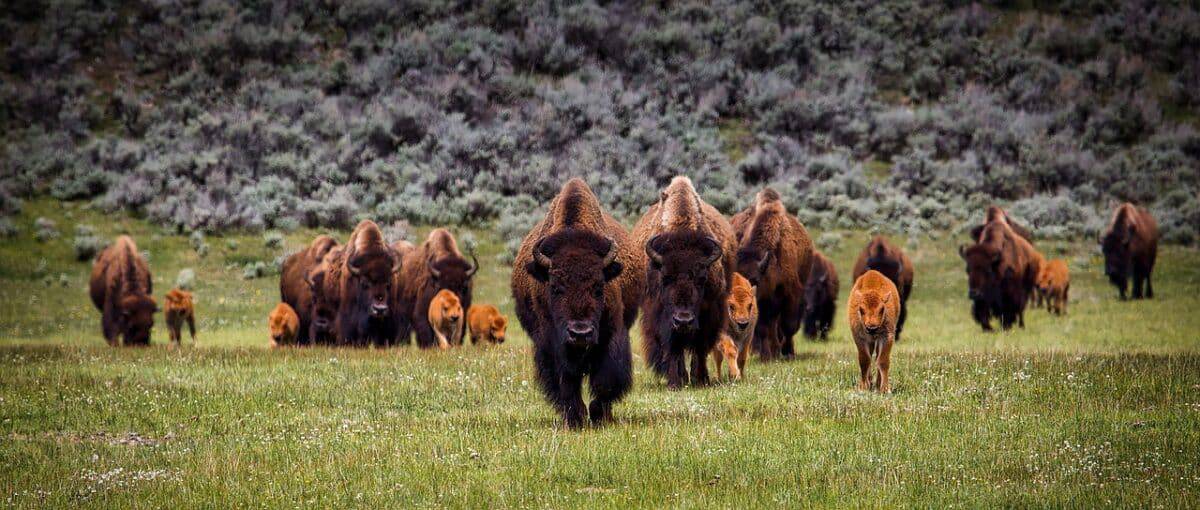
Let’s kick off our journey through Wyoming’s wildlife with the mighty Bison, a creature held in such high regard that Wyoming declared it the official state mammal in 1985. This iconic symbol is also representative of Kansas and Oklahoma, and, as of May 9, 2016, proudly stands as the official national mammal of the USA.
Venturing into the heart of Yellowstone National Park becomes an extraordinary experience, as it remains the sole location in the United States where Bison have thrived uninterrupted since ancient times. The Yellowstone bison herds are truly exceptional, constituting the nation’s largest population on public land. Unlike many others, these herds, numbering in the thousands, roam freely across the vast landscapes of Yellowstone National Park and adjacent areas in Montana.
Behavior
These magnificent Bison, reminiscent of their ancient ancestors, showcase untamed behaviors during the breeding season, gathering to compete for mates and engaging in migrations and explorations to embrace new habitats. This spirited conduct has been instrumental in the remarkable recovery of a population that teetered on the brink of extinction just over a century ago.
Despite their remarkable resurgence, Yellowstone bison face challenges such as brucellosis, a livestock disease that can be transmitted to wild bison, elk, and cattle through contact with infected fetal tissue. To navigate potential conflicts with ranching and other activities beyond the park borders, the National Park Service collaborates with federal, state, and tribal agencies to implement policies for bison access to habitat in Montana. The conservation of wild bison poses as one of the most intricate challenges in managing Yellowstone’s rich ecological tapestry.
As the largest land-dwelling mammal in North America, Bison males, weighing around 900 kg, surpass their female counterparts, who weigh approximately 500 kg. Cloaked in a dark chocolate-brown hue, both genders boast long hair on their forelegs, head, and shoulders, complemented by short, dense hair (3 cm) on their flanks and hindquarters. Calves, born after 9 to 9-½ months of gestation, sport a reddish-tan coat at birth, gradually transforming into a rich brown shade after 2-½ months. Both sexes flaunt relatively short horns curving upward, with males having slightly longer horns compared to adult females.
Physical Characteristic
Bison exhibit a distinctive shoulder hump, a prominent feature facilitated by robust shoulder and neck muscles. This physical adaptation enables bison to skillfully sway their heads from side to side, clearing snow from foraging patches—an unconventional approach compared to other ungulates that typically use their front feet to scrape away snow. Renowned for their agility, bison are formidable swimmers and boast an impressive running speed of 35 miles per hour (55 km/h). Their athleticism extends to jumping over obstacles approximately 5 feet (1.5 m) high, highlighting their remarkable strength and dexterity. Additionally, bison possess excellent hearing, vision, and a keen sense of smell, contributing to their prowess in navigating diverse landscapes.
Bison, the largest land-dwelling mammals in North America, exhibit sexual dimorphism, with males weighing around 2,000 lbs (900 kg) and females approximately 1,100 lbs (500 kg). Their coloration is generally a dark chocolate-brown hue, with males and females adorned with long hair on their forelegs, head, and shoulders. However, their flanks and hindquarters feature short, dense hair measuring 1 inch (3 cm) in length. Calves are born with a reddish-tan coat after a gestation period of 9 to 9-½ months, transitioning to brown approximately 2-½ months after birth. Both genders possess relatively short horns that curve upward, with males having slightly longer horns than adult females.
Strong swimmers?
All bison have a protruding shoulder hump. Ample shoulder and neck muscles allow bison to swing their heads from side to side to clear snow from foraging patches, unlike other ungulates that scrape snow away with their front feet. Bison are agile, strong swimmers and can run 35 miles per hour (55 kph). They can jump over objects about 5 feet (1.5 m) high and have excellent hearing, vision, and sense of smell—the wonderful Wildlife in Wyoming.
Yellowstone bison are primarily herbivores, with over 90% of their diet consisting of grasses, sedges, and other grass-like plants in open grassland and meadow communities. Throughout the year, they also consume forbs (weeds and broad-leafed plants) and browse (woody plants’ leaves, stems, and twigs), making up less than 5% of their diet. Bison typically forage for 9 to 11 hours daily.
As ruminants, Yellowstone bison possess a multiple-chambered stomach housing microorganisms like bacteria and protozoa, aiding in the effective digestion of plant material. They engage in rumination, a process of regurgitating partially digested food and re-chewing it, allowing microorganisms to further break down plant material into volatile fatty acids and other compounds. This unique digestive system enables them to efficiently process lower-quality foods compared to other ungulates.
Adult bison face predation from wolves and grizzly bears, with deceased bison serving as a crucial food source for scavengers and carnivores. Bison employ various behaviors, such as rubbing against trees and rocks or wallowing in dirt, to rid themselves of insect pests. Birds like magpies perch on bison to feed on insects in their coats, while cowbirds follow closely, capitalizing on insects disturbed by the bison’s movements.
Mountain Lions
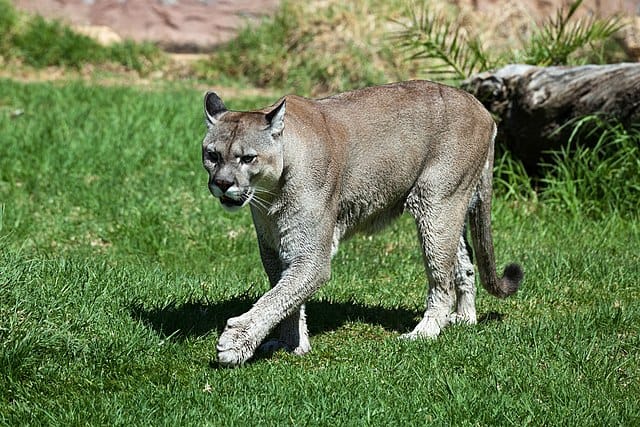
Mountain Lions, scientifically known as Puma concolor or cougar, are large brownish New World cats, comparable in size to the jaguar—the only other large cat in the Western Hemisphere. Also referred to as panther (in the eastern U.S.) or catamount (archaic), these members of the Felidae family boast the broadest distribution among New World mammals, spanning from south Eastern Alaska to southern Argentina and Chile.
Pumas inhabit diverse environments, including desert scrub, chaparral, swamps, and forests, with a preference for areas providing cover (vegetative or topographic). Primarily active during dusk, night, and dawn, they are skilled predators, with their primary prey being hoofed mammals, especially deer, larger than themselves. In North America, each puma averages about 48 ungulate kills annually, along with various smaller prey such as rabbits, hares, coyotes, bobcats, porcupines, beavers, opossums, raccoons, skunks, and other pumas. While domestic livestock, including sheep, goats, and young calves, may also be taken, it is uncommon for pumas to scavenge on carcasses they did not kill.
On the Hunt
During the hunt, a puma covers approximately 10 km (6 miles) per night, engaging in several travel bouts lasting around 1.2 hours each. This pattern involves alternating between periods of travel, stalking, waiting in ambush, or resting. While slower than most prey, the puma utilizes its stealth, often springing from cover at close range, typically from behind the intended victim. To minimize spoilage and deter scavengers, the puma drags the carcass to a secluded cache site, covering it with leaves and debris. Throughout the day, the cat commonly beds within 50 meters of the kill, feeding for an average of three nights on a large prey. It’s noteworthy that a puma rarely beds in the exact location on successive days unless feeding on a particularly substantial kill.
Adult male and female pumas are typically solitary, except for brief breeding associations lasting one to six days. Pumas are generally silent, but during breeding periods, they emit long, eerie screams intermittently for several hours. Breeding occurs throughout the year, with a peak in births during the summer in higher latitudes. The interval between births is approximately two years, although it can be shorter if a litter disperses or dies early in the process.
Cubs
Cubs enter the world after a 90-day gestation period, typically in litters of three but ranging from one to six. Weighing about half a kilogram each, they are born spotted and blind. The birthing site, often located in nearly impenetrable vegetation, is meticulously maintained, free of feces and prey remains. It lacks visible modifications and is abandoned when the cubs reach approximately 40–70 days old. Cubs are raised without assistance from adult males, and occasionally, males not related to the cubs may pose a threat, leading to fatal outcomes.
The cubs stay with their mother until dispersing at 10–26 months of age, but sadly, many do not survive to fend for themselves. If a cub survives the critical first two years, juvenile females typically spread across distances of 9–140 km (average 32 km), while adolescent males often disperse farther, occasionally covering more than 250 km. It may take a year for them to become part of the breeding population. During this transition, individuals may sequentially occupy and abandon one to five small transient home ranges. If a home range is successfully established, the cat can be expected to live another 7–11 years. While wolves and bears may occasionally pose threats to pumas, most deaths result from human factors, including hunters, other cougars, or motor vehicle collisions.
Additionally
In the wildlife of Wyoming, adult males and females lead solitary lives except during breeding associations lasting one to six days. Pumas are typically silent, but during the breeding season, they emit long, frightening screams intermittently for several hours. Breeding occurs throughout the year, with a summer peak in births at higher latitudes. The interval between births is approximately two years, although this may be shorter if a litter dies or disperses early.
Cubs are born after a 90-day gestation period, usually in litters of three but ranging from one to six. Spotted and born blind, each cub weighs about half a kilogram. The birth site, often located in nearly impenetrable vegetation, is meticulously maintained, free of feces and prey remains, and lacks apparent modifications. It is abandoned when the cubs are about 40–70 days old. Cubs are raised without assistance from adult males, though occasionally, unrelated males may pose a threat, resulting in the killing of cubs. Cubs accompany their mother until dispersing at 10–26 months of age, but unfortunately, many do not survive to fend for themselves. If they survive their first two years, juvenile females typically cover distances of 9–140 km (average 32 km), while adolescent males often disperse farther, sometimes traveling more than 250 km.
Breeding Transition
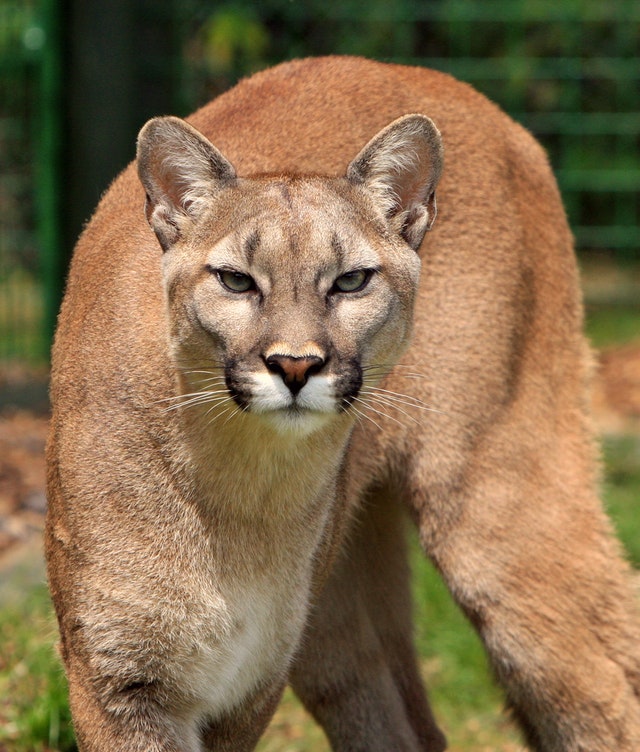
It may take up to a year for young pumas to become part of the breeding population. During this transitional period, an individual may sequentially occupy and abandon one to five small transient home ranges. If a home range can be successfully established, the cat can be expected to live another 7–11 years. While wolves and bears occasionally pose threats to pumas, sometimes commandeering the carcasses of prey killed by them, most deaths are attributable to hunters, other cougars, or motor vehicles, making them a significant aspect of Wyoming’s wildlife.
Pumas thrive at low density, with an average of one to five individuals per 100 square km. To survive, they require large areas with sufficient prey and cover for ambushing. In a given region, there are approximately two adult females for every male. Female home ranges exhibit extensive overlap, while territories of adjacent males have minimal overlap. Home ranges vary significantly, with the average female domain spanning 140 square km (54 square miles), and male territories are about twice as large.
Wolverines
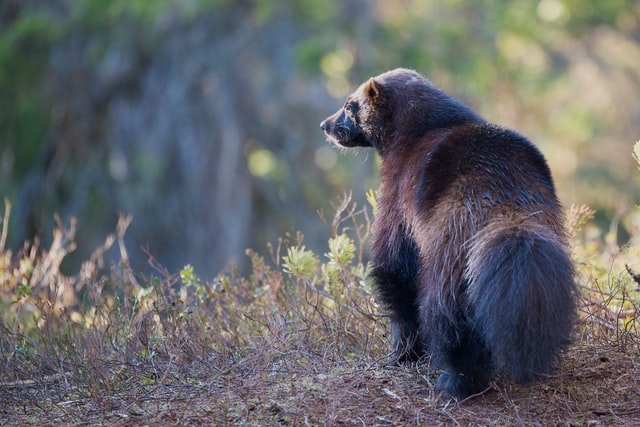
Also known as Gulo gulo, the wolverine is the most prominent terrestrial member of the weasel family. Wolverines are naturally rare and persist at extremely low population densities. Very few individual wolverines have been detected in Wyoming, including Grand Teton National Park and Yellowstone National Park.
The current status and distribution of wolverines in Wyoming are largely unknown, with vast tracts of potential wolverine habitats in the state’s high country. While formal wolverine surveys and research have been conducted in the Teton Range and Yellowstone National Park, detections outside of these areas are scarce.
Recent research has revealed that the worldwide distribution of wolverines is closely tied to the persistent late spring (April and May) snowpack distribution. Females dig dens in deep snow to give birth and raise young until they are old enough to venture out. Year-round, wolverines utilize higher elevations where snow persists and temperatures stay cool, typically above 8,000 feet.
Wolverine
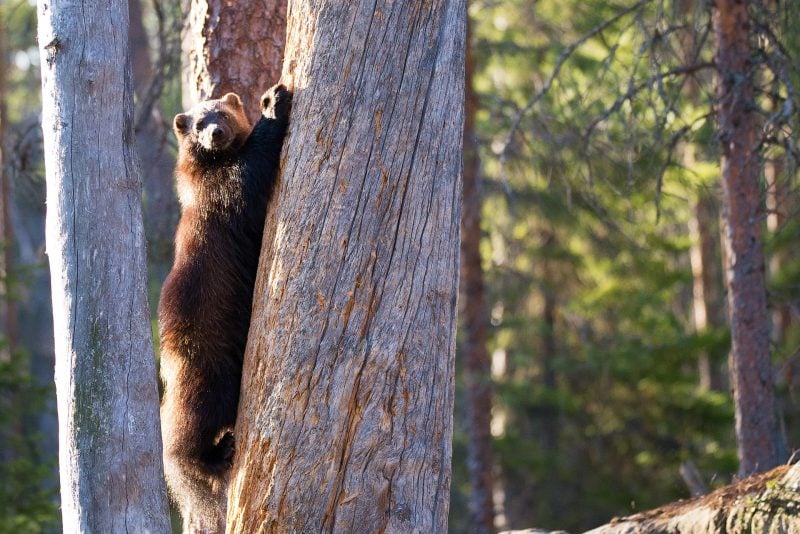
Conservation efforts for wolverines have faced challenges due to a limited understanding of the fundamental ecology and distribution of this native species. Recent research initiatives have started to enhance this situation, yet further work is necessary to determine the habitats that wolverines inhabit and to comprehend demographic measures essential for the persistence of the population.
Bobcats
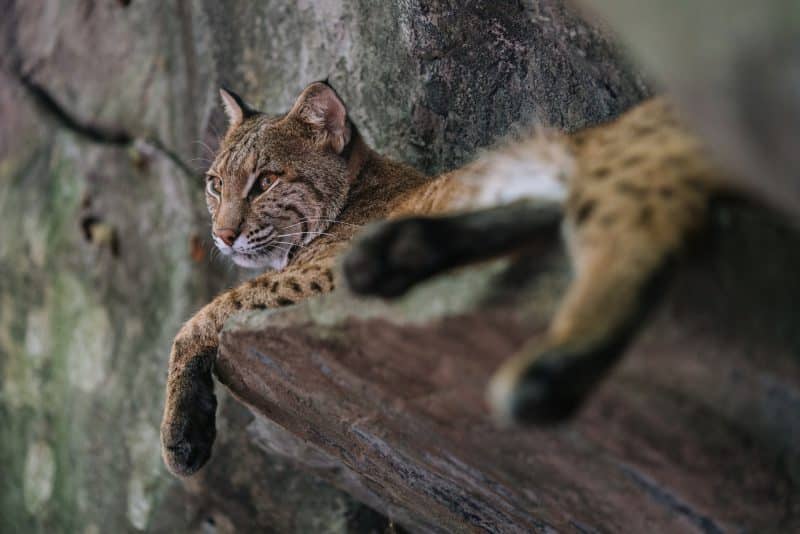
The bobcat (Lynx rufus), also known as the “wildcat,” is a medium-sized member of the North American cat family. Distinguished by its graceful catlike movements, short “bobbed” tail (10 to 15 cm), round face, and pointed ears, it features black hair at the tip of the ears and prominent white dots on the upper side. Body hair color varies, with sides and flanks typically brownish-black or reddish-brown, adorned with distinct or faint black spots. The back is commonly brownish-yellow, with a dark line down the middle. The chest and outer legs display brownish to light grey fur with black spots or bars.
The bobcat is two to three times the size of a domestic cat, appearing more muscular and fuller in the body, with hind legs proportionately longer than the front legs.
Behaviorally, bobcats are secretive, shy, and solitary, often avoiding human observation. They are active during the day but prefer twilight, dawn, or nighttime hours. Using well-worn animal trails, logging roads, and other paths, bobcats rely on acute vision and hearing to locate enemies and prey.
Bobcats do not form lasting pair bonds, and mating can occur between most adult individuals. In Wyoming, female bobcats reach sexual maturity within their first year, while males mature sexually in their second year. Breeding occurs nationally from January to June, with Wyoming’s breeding typically commencing in February and the first estrus cycle in mid-March. The gestation period ranges from 50 to 70 days, averaging 62 days.
Breeding Season
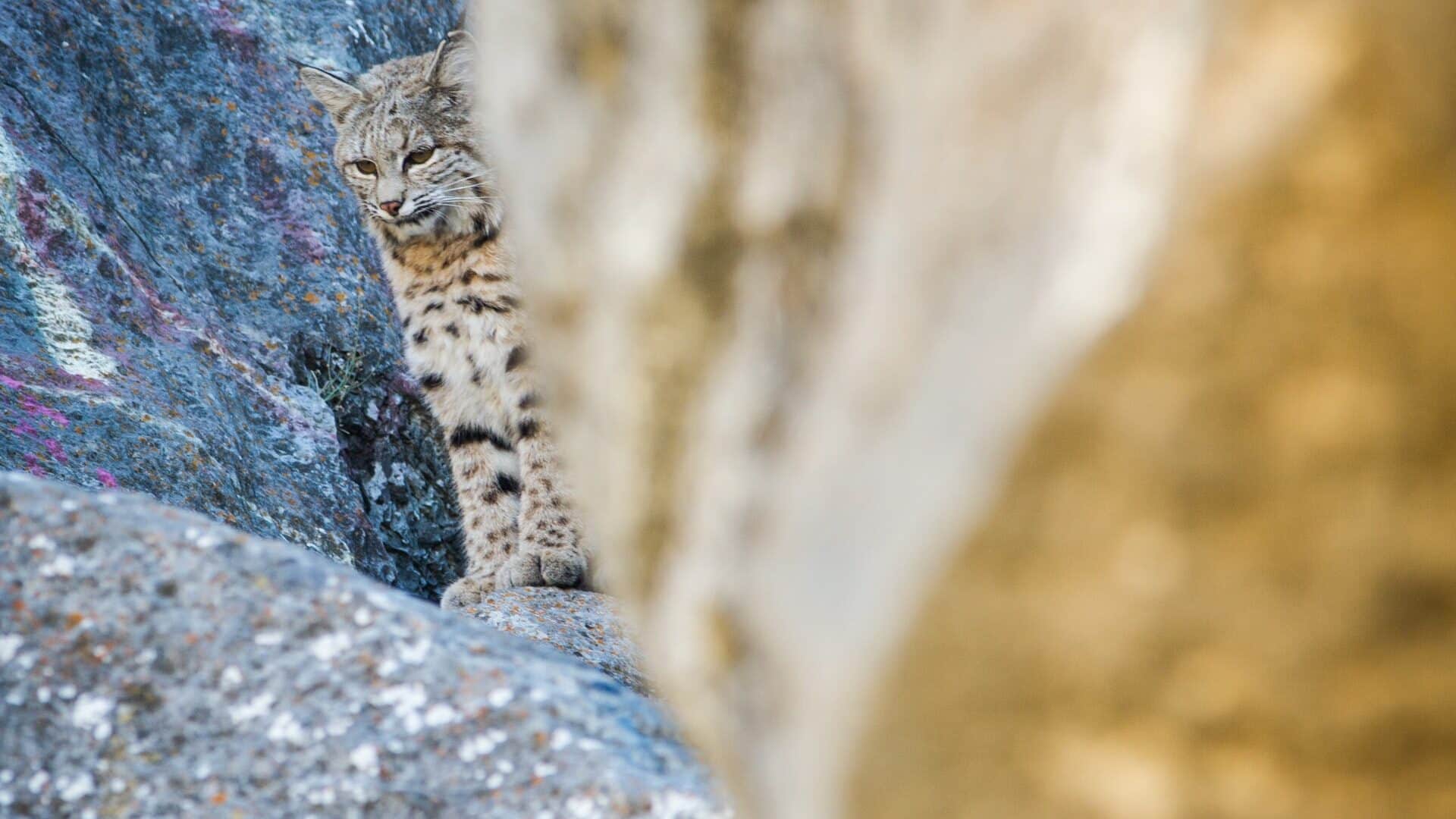
Nationwide, young bobcats are born from March to July, with litters as late as October. The breeding season’s timing is influenced by factors such as latitude, altitude, longitude, and characteristics of each bobcat population. In Wyoming, births peak from mid-May to mid-June, with late litters occurring as late as August or September, potentially from recycling or late-cycling females, particularly yearlings. In Utah, births may peak in April or May, while in Arkansas, they may peak as early as March.
Bobcat kittens weigh about 2/3 pounds (300 g) at birth, and litters typically contain 2 to 4 kittens. Nursing lasts for approximately 60 days, and the kittens may accompany their mother through their first winter. While young bobcats experience growth in their first six months, males may not be fully grown until 1 1/2 years, and females until two years of age. Bobcats can live for at least 12 years in the wild.
Bobcats are adept hunters, capable of taking down prey ranging from the size of a mouse to that of a deer. Their diet primarily consists of rabbits, tree squirrels, ground squirrels, wood rats, porcupines, pocket gophers, and groundhogs. They also consume opossums, raccoons, grouse, wild turkeys, and other ground-nesting birds. Occasionally, insects and reptiles may be part of the bobcat’s diet. In Canada, the snowshoe hare is a favorite fare. Bobcats may sometimes kill livestock and engage in scavenging.
Grizzly Bears and Black Bears
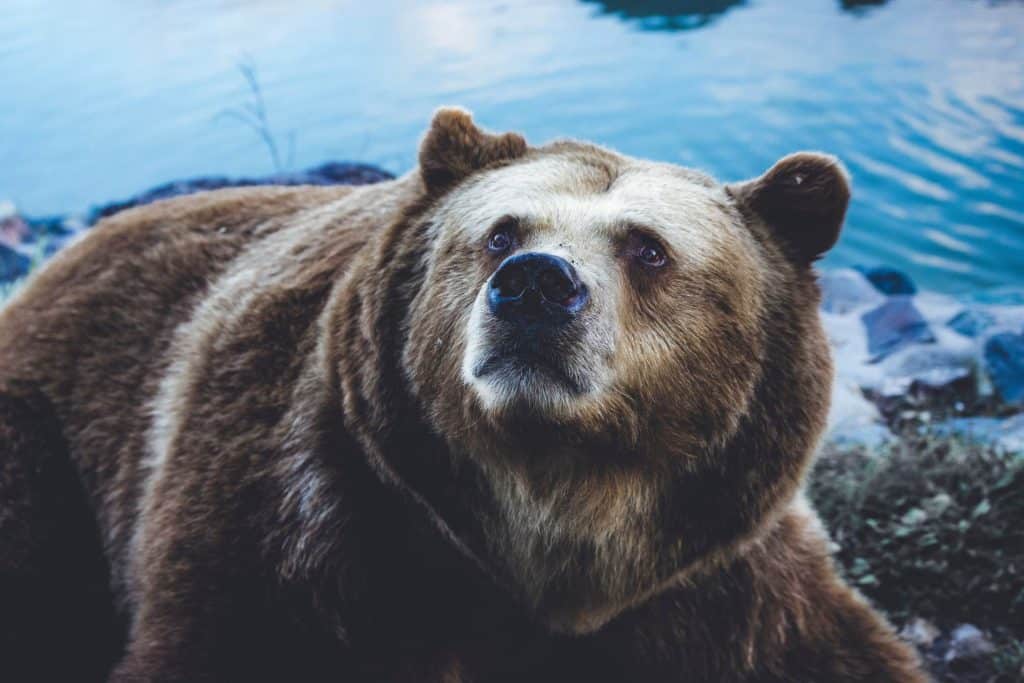
Grizzly Bears and Black Bears are plentiful in Wyoming, especially in Yellowstone and Teton National Park! Read more about these species in our related blog articles about:
Where you can see and Encounter Black Bears
Wild Horses in Wyoming
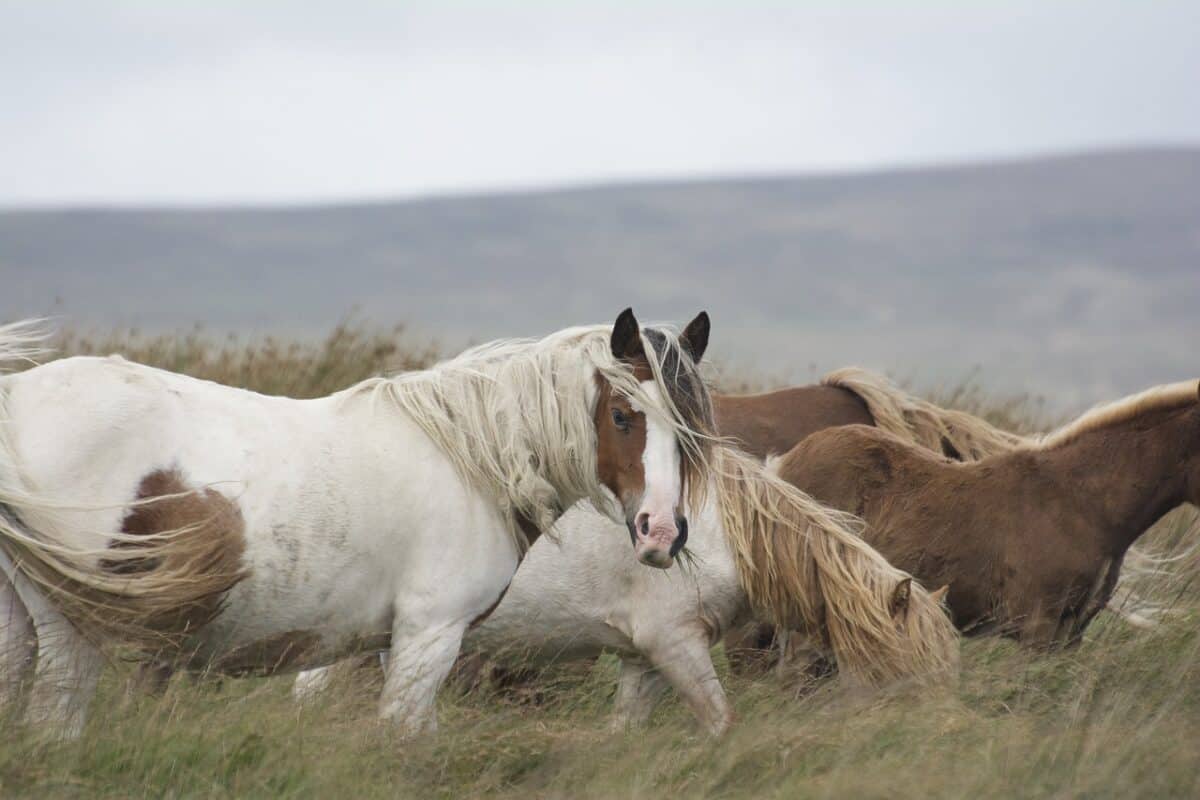
Wild horses, iconic symbols of the American West, represent the untamed spirit of the frontier and a connection to wide-open landscapes. Horses initially appeared in the Americas around 10,000 years ago but went extinct for unknown reasons. They reappeared approximately 9,000 years later when Spanish explorers reintroduced them in the 1500s.
In Wyoming, the majority of wild horses are found in the southwestern quarter of the state, with the Rock Springs BLM serving as the headquarters for the Wild Horse Program. The appropriate management level for wild horses in Wyoming is around 6,000, with 2,500 of these horses located in the Rock Springs District. The Rock Springs District features a checkerboard pattern of federal and private lands, contributing significantly to the wildlife diversity in Wyoming.
The existence of wild horse herds in the region is credited to private landowners who refrain from fencing their land, allowing the horses to roam freely for food, water, and shelter, especially during winter—a testament to the harmonious coexistence of these beautiful creatures in Wyoming’s wildlife.
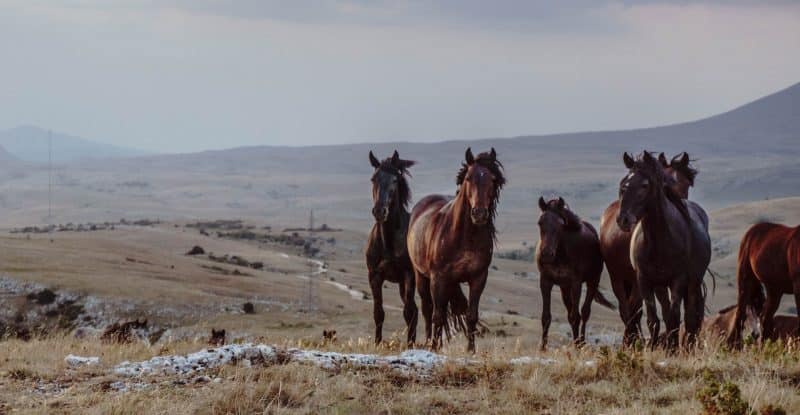
Wild horses have no actual natural predators other than the occasional mountain lion. As a result, populations can increase at a very high rate. This rate of increase is generally about 20% per year, with good years topping 40%. When people of wildlife, wild horses, and domestic livestock exceed the capabilities of their habitat, the environment begins to suffer. If prolonged, it leads to poor rangeland and an overall decline in the health of the wild horses…
Summary of Wildlife in Wyoming
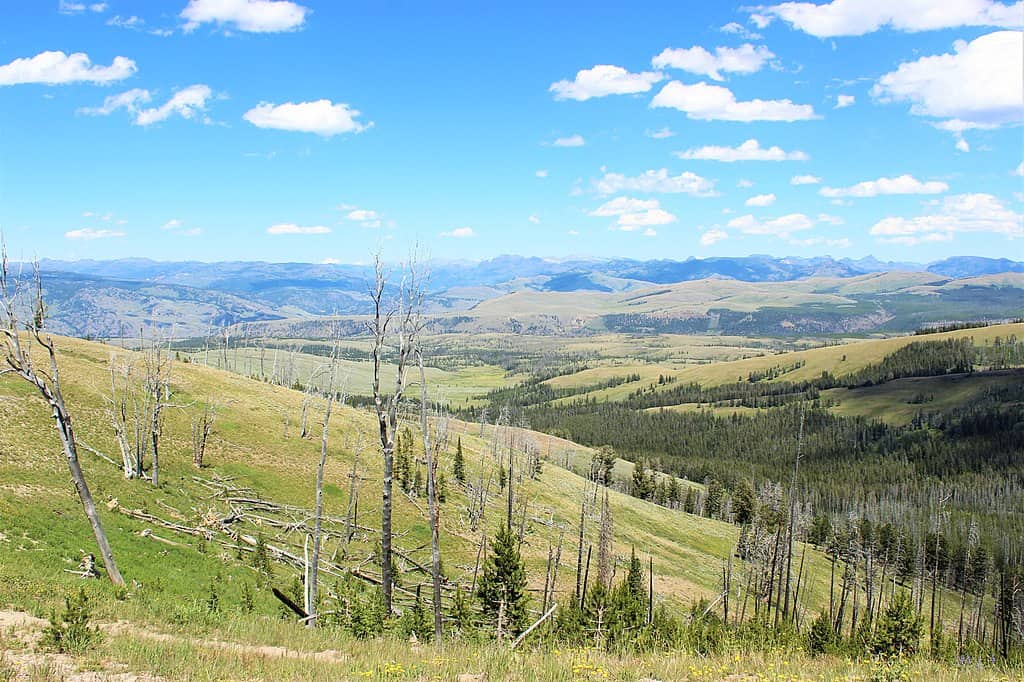
I hope you enjoyed reading a little bit about Wildlife in Wyoming. Not only is it one of the most incredible wildlife-dense states in America, its amazing National Parks, such as Yellowstone and Teton, make the visit all the more worthwhile! If visiting Wyoming is now on your bucket list, here are some operators who may help you on your journey to discovering the “Wild West.” Thanks for reading Wildlife in Wyoming.
Yellowstone National Park Trips
Travel Wyoming: Grand Teton National Park
If you enjoyed this blog, you might be interested in blogs about the US or Wildlife in Alaska.
Frequently Asked Questions (FAQs)
Yes, Wyoming is home to a diverse range of wildlife species due to its varied ecosystems and landscapes.
While there are many common animals in Wyoming, one of the most iconic and commonly seen is the mule deer.
Wyoming has a variety of predators including wolves, mountain lions (pumas), black bears, coyotes, and bobcats.
Yellowstone National Park, located in the northwestern part of Wyoming, is known for its abundant and diverse wildlife population.
Yes, Wyoming is one of the states where grizzly bears can be found, particularly in areas like Yellowstone National Park and the Greater Yellowstone Ecosystem.
Join our Forum for free today!

- Third Elk Incident in Two Weeks in Estes Park, Colorado and How to Stay Safe - July 4, 2024
- 17 Animals That Mate For Life - June 24, 2024
- 13 Animals That Lay Eggs (Some Might Surprise You!) - June 16, 2024

